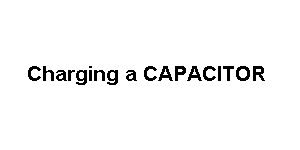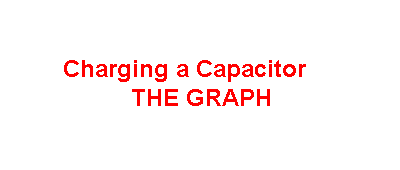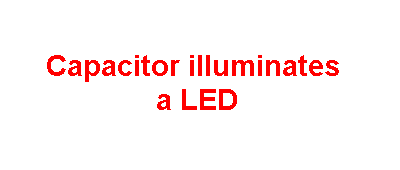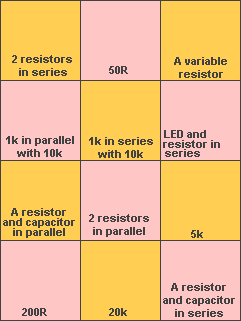|
BASIC
ELECTRONICS COURSE
Page 2

Question 28: How can you make a 292 ohm
resistor?
Ans: This is an
unusual request but two resistors from the "standard range" of resistors can be placed in series and the final resistance is the ADDITION
of the two values. You will learn more about this later but the two
standard values to use are 220 ohm and 68 ohm, making a total of 220 + 68 = 288
ohm.

To see the
pages on RESISTORS IN SERIES - you need to subscribe
Question 29: How do you connect
resistors in parallel?
Ans: See
animation:

Question
29a: Can you make a 292 ohm
resistor with resistors in parallel?
Ans: Yes you can,
but the maths is very complex.
To see the
pages on RESISTORS IN PARALLEL - you need to subscribe
TEST:
Drag the components to the correct position on the
map. Click to release:
Question 30: The resistor is a common
component in an electronic circuit. Name another common component.
Ans: the
capacitor.
There are a number of different types of capacitor and here are 4 from our Library of
Symbols: (you need to subscribe to access the Library)




Question 31: How does a capacitor work?
Ans: When a
voltage is connected to a capacitor it charges up. It's a bit like charging the
battery in your mobile phone. In fact the mobile phone battery can be considered to be a very large capacitor.

Question 32: Does a capacitor
"fill up" (charge) at a constant rate?
Ans: No. A fully
discharged capacitor fills up (charges) at a fast rate at the beginning of its charge-cycle and and fills-up at a slower and slower
rate. It's a bit like filling a car with petrol. The driver fills up quickly at the
beginning and as he know the tank is getting full, he slows down the flow of
petrol. With a capacitor, this charge-rate is a natural phenomena.
Question 33: Why does a capacitor
"fill-up" at a slower and slower rate?
Ans: It's
to do with the voltage of the supply that is charging the capacitor.
Another name for voltage is "pressure." When a capacitor is uncharged,
it
has zero voltage across it (in it) and the pressure of the supply voltage will
allow a high current to flow and this will begin to charge the capacitor very
quickly.
As it gets charged, a voltage builds up across the capacitor and this opposes
the voltage of the supply. The result is the supply voltage sees and opposing
voltage and thus it does not have as much "pressure" as before to
deliver the current into the capacitor and the "rate of charge"
decreases. The "time-lapse animation below shows how the capacitor
fills up quickly at the beginning and the filling process slows down.
The graph shows the voltage across the capacitor does not rise in a linear
(straight line).
All you have to remember is the fact that a capacitor does not charge in a
linear fashion but if you consider the first part of the charging curve, the
rise is fairly linear!

Question 34: Can we charge a capacitor
then connect the capacitor to a LED?
Ans: Yes. The LED
will illuminate brightly then gradually dim as shown in the animation:

WHAT
HAVE WE COVERED?
We have shown how to connect a LED to a
supply (a supply voltage) and turn it on by selecting a suitable current
limiting resistor to give the required illumination.
The resistor can be a single resistor or two resistors in series. We have shown
that the total resistance of two resistors in series is the ADDITION of their
resistance values. The LED must
be connected to a supply around the correct way, with the anode lead to the positive rail
and the cathode lead to the negative rail, via a current limiting resistor. The voltage
that develops across a LED when it is operating is called the
"characteristic voltage" and for a red LED this is 1.7v. The maximum
current for a LED is 25mA and the correct current limiting resistor value can be worked
out using Ohms Law.
We have shown how a capacitor charges when connected to a supply voltage. The
charge-rate is not linear but that will be explained in more detail later. A
capacitor is like a rechargeable battery. It can be charged and its energy used
to operate a device.
From
your instructor:
As you work through this course, you will be asking "where does it
lead me?"
It will take a few pages to see the theory we are covering is both simple and complex
at the same time! And it's all
being done without the frustration of mathematics and frustrating questioning.
One of the main areas where electronics is showing its potential in the world
around us, is toys.
We
have seen the Furby, the Timogotchie, talking parrot and computer chess game.
All these were an enormous leap for electronics at the time and the same quantum
leap can occur today. Electronics has only reached a few percent of its potential
and every year the capability broadens.
The heart of many electronics-based products lies in a chip called a microcontroller.
This is a completely empty chip that can be programmed to perform
almost any task. If you look at the Furby, it displays walking, talking, responding to stimuli and creating an impression of
"intelligence."
We have just mentioned the greatest aim of all
electronics programmers. To produce a product that appears
to have intelligence.
You are in luck. This is the aim of this course.
The
basic electronics section is designed to teach you about circuits (building
blocks) to connect (interface) a microcontroller to the outside world. It is
necessary to connect photocells (light cells), microphones, motors and speakers
etc to the "micro" so that the project can perform its magic.
The pages of this course cover three main areas:
1. Basic electronics
2. Microcontroller Programming
3. Construction of projects.
To complete this course you have to cover all three areas.
However the main area is projects. As you work your way through
the course, projects will be available "at the click of a button." Some
will be very simple and you may be tempted to skip over them. It's a
bit like leaving out the long-division section of mathematics. Some day you will need it. Every kit
introduces a different building block and you need all these blocks if you want
to start designing your own projects.
It's a simple equation. The more "hands on" practical knowledge you
gain, the more adept and confident you will be as a design engineer.
You may not be enthusiastic about designing the next generation of toys, but
this is just one of the areas where you can produce a product, launch it on the
market and see an enormous return, all within 12 months.
Alongside toys are all those other devices that have hit the market in recent
times: Beeping
keychains, LED torches, Laser pointers, solid state memo recorders, spy cameras,
alcohol detectors, smoke alarms - and the list goes on. All have made a fortune
for their inventor.
Don't be like the US Patents Office. About 50 years ago it was going to be
closed down because "everything had been invented." Invention breeds
invention. Who would have thought the flexibility of a Rubiks' cube could be
possible?
Ideas come from ideas.
Every day I think of ideas that could be invented to improve a certain
situation.
All you have to do is be in the right place at the right time.
And if you have the capability of creating the product to meet the situation,
you can be a winner.
Look at the inventor of the "Super Soaker." Simply a garden hose
with a jet for children to play under, on a hot day. He has sold millions of
items.
The advantage of electronics is simplicity. You don't need complex manufacturing
processes to produce your product. You can simply produce the first prototype for
a few dollars and have it accessed. Obviously there will be some
developmental costs but due to the universal nature of electronic componentry,
you can produce the product yourself.
Now here's the exciting part.
The heart of anything you design will be the program in the microcontroller. By
using the latest range of microcontrollers, the program within
the chip and will not be available to any outside source. This
means anything you design will be protected from copying.
This is one of the greatest advances in electronics.
Your intellectual
input can now be kept safe from prying eyes.
That's the path we will be following. You have
started now, so keep
it up. It's the most rewarding, interesting
career you can take.
I will contact you again later,
Colin Mitchell.
Course Instructor.
|
|
|
 |
 |

|




